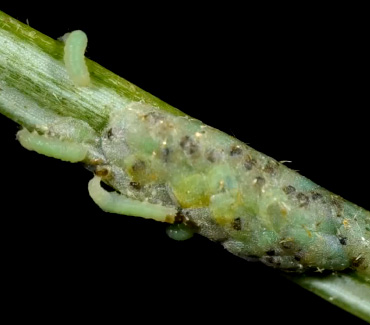Small World in Motion Honorable Mention Winner Highlight: Dr. Ward Strong

Posted on August 05, 2014
To the naked eye, there’s nothing exciting or even noticeable about the tiny egg mass on a spruce needle. But look a little closer, at just the right time, and you might just see something fascinating.
Dr. Ward Strong of Vernon, Canada happened to be in the right place at the right time, looking at a specific spruce needle. The result? An enthralling stop-motion video featuring fifty spruce budworms hatching simultaneously from an egg mass, chewing their way out as individual larvae. Through use of a Greenough Stereo Microscope at 15x magnification paired with a Nikon D90 controlled with a computer to take pictures every five seconds, Dr. Strong was able to capture about 1400 images, which he then assembled into a movie at twenty frames per second. “What I think is amazing is when you’re looking at these by eye, in real time, it happens very slowly, over two hours. It’s an inconspicuous egg mass on a spruce needle; you wouldn’t notice it,” says Dr. Strong. “But speed it up, you see how truly fascinating it is. Simultaneously it froths and bubbles, as each budworm begins squirming and wiggling to escape.”
Spruce budworms lay their eggs in summer and hatch in August, producing only a single generation each year. Once they escape the egg mass, each tiny larva burrows into a needle and spends the winter there, safe from natural enemies and the elements. In spring, it resumes feeding on the tree. It’s these feeding habits that caught the attention of Dr. Strong and his research team, who for the past three years have studied the genomics of pest resistance in trees in collaboration with University of British Columbia in Vancouver.
Thanks to increasingly rapid climate change, trees are becoming less and less adapted to the places they live – and therefore more susceptible to pests and insects such as spruce budworms. While some trees are more resistant to pests than others, Dr. Strong’s team noted that the current breeding system is too slow to keep up with the changing climate. They set out to assist this process with genomic marker assisted selection – a brand-new mechanism they hope will someday improve breeding in trees that are resistant to pests. Spruce budworms such as those captured in Dr. Strong’s winning entry have been vital to this study, as researchers observed which trees the budworms prefer to feed upon, and which trees are resistant. Identifying markers in the tree DNA that correlate with weevil resistance will ultimately speed the process of breeding weevil-resistant trees, thus improving our ability to respond to climate change. As a model system for a new technology, this project also promises applications in breeding for any desirable trait in trees.
According to Dr. Strong, this winning video captures more than just the research behind it. “As a scientist with a passion for the arts, photography through microscopes has been a very strong theme in my life and career,” says Dr. Strong. “I’m enthralled with the opportunity provided by this technology, to show the world what is happening under the microscope. There’s an astounding, beautiful, fascinating world under there… if we only take a moment to look a little closer.”
